Executive Summary
The main purpose of the paper is to discuss the brand and product management to strengthen the company. This paper will consider all the relevant issues of the brand audit by considering the well-known Australian company Boost juice bar. Most of the big companies have initiated their brand audit to understand and assess their brand position in the market and try to find out the way to improve the current performance of the brand through new actions. There are mainly two types of brand audit, such as the inventory audit and the exploratory audit. Inventory audit includes the brand identity, brand equity, brand positioning and the point of parity and point of difference. In exploratory audit, companies want to measure how customers think or see a particular brand.
Literature Review
Brand Audit
Wallström & Salehi (2008) mentioned that building a brand is very important in corporate level and it requires frequent audit to strengthen the brand. Brand audit refers to the identification of internal and external issues regarding a specific brand or brands of an organisation. Like financial audit, a brand audit also addresses various matters of a product, such as, its current positioning on the market, its equity, values, identification tools, and the customers’ assessments on the brand. To sum up, brand audit measures the comparative strength and weakness of a product. Brand audits are mainly done to identify the gap between the expectation and the actual situation. Brand audit is broadly divided into two parts:
- Inventory Audit
- Exploratory Audit
Inventory Audit
Chattopadhyay & Jean-Louis (2005) argued that inventory audit is carried out from the perspective of the company and this includes the appraisal of various programs it undertakes to establish a brand in the market. The main reason behind the inventory audit is to measure the efficiency and effectiveness of the program taken by the company for promoting the brand. This audit examines all the projects retained by the business for its existing product or products starting from brand identity to the brand positioning in the market. Some specific elements that must cover in executing inventory are as follows:
Brand Identity: Brand identity refers to the techniques by which a brand can be identified in the market. An organisation can signify its brand in the market in several ways. The First is the logo or trademark of the company, the second is the use heavy advertising efforts by the company. Finally, the business can use brochures, business cards, business stationeries, color platters and other office equipment to identify its brands. According to Romaniuk et al, (2004) brand awareness also helps the customer to identify the brand in the market.
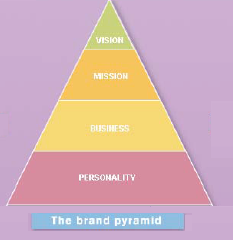
Brand vision: Vision generally refers to the objectives that an organisation tries to hit over a long period. Brand vision is the long-term goal of a company where a manager wants the brand to reach over a long time at top of market. Most of the organisation wants to orient the brand all over the world, and in case of small company, they may to want to introduce the brand countrywide. Brand audit must address the issue and examine whether the brand vision is compatible with the environment and the current activities of the company.
Brand Mission: In general, mission is a short-term goal of an organization where it wants to reach immediately. Brand mission is a statement where a company integrates three basis values, which are the product or brand value, the business or company value and finally the customer value. The mission statement should not too long, so that the customers cannot remember it and should not too short, so that it does not carry values. The inventory audit also examines the feasibility of the brand mission of the company or brand.
- Slogan: Sutherland (2004) expressed that slogan is a combination of some words, which explains what, and why the brand is in short and it uses for marketing campaign. The slogan is a group of word that indicates the brands and customers easily recognize the brand when hearing or reading the slogan such as when people hear “Get the Cat”, they easily understand it is about the Caterpillar of USA.
- Logo: Logo is an image or mark, which identify the brand without the name of the company or brand. It is a unique mark of the brand, which is very different and easily identifiable by the customers. Sometime company integrates the slogan in the brand logo and that time slogan and logo carries same meaning.
- Packaging: Packaging is a process of covering the product by any substance, which protects the product from any damage. Packaging has a special importance in branding and company uses this packaging to send the brand massage to the target customers. The design, colour, and size of the packaging bear the brand in the mind of the customers. As an example, the Orange mobile in Australia always use orange color packaging to send the brand massage to the customers.
- Brand Hierarchy: Gopal & Rajagopal (2007) stated that brand hierarchy is the evolution of the brand from one-step to another step that means a company can starts its branding from the local stores and gradually it turns into a global brand. The hierarchy, which a brand follows logically in course of its journey in the market, is brand hierarchy. In case of Coca-Cola, its starts its journey in USA and over time it secures its position as world’s top brand. Another issue of brand hierarchy is the change of the product line or features in course of its evolution such Nokia initially starts business as a paper producers in 1985, now it is a top brand in communication device in the world. In brand inventory audit the auditor should look over the brand hierarchy of the company or brand.
- Brand portfolio: Kuzmina (2009) stated that brand portfolio is the total or mix of all brand, sub brands, and co brands of a particular organization. It is very important for brand audit as the success of a particular brand largely depends on the optimum mix of the portfolio of the brand of a company. As an example, Sony Corporation of Japan has several brands in color television such as Vravia, Waga, Sony etc., and performance of one brand affect the other brand both positively and negatively.
- Brand Loyalty: Brand loyalty is an important part of the brand audit it assesses the loyalty level of the customer to a particular brand. Worthington, Russell-Bennett & Härtel (2009) argued that a brand loyalty audit works on three level of loyalty of the customers that is loyalty shows in attitudes, loyalty shows in emotions and finally loyalty shows in cognitive process them.
Brand Equity: Raggio & Leone (2007) argued that brand equity is the sum amount of all the economic values that come from the customers, which build, based on the expectation of the customers over the brand or company, level of communication address to them and finally the customers long-term experience over the definite brands. The brand equity can measure in several ways such as the power of brand over the customers, the brands inherent values, the premium pricing charged by the brand, the loyalty gain by the brand, and finally the market shares gain by the brand in a passage of time. In a sense of economy, brand equity refers to the change in customer demand curve of a particular product or services.
Brand Equity Pyramid: Quarles argues that brand equity follows a logical manner in which the various brand assets are position in a hierarchy such as brand awareness, brand image, Purchase and investment interest, customer loyalty etc. Here brand image helps to build the base of the brand equity.
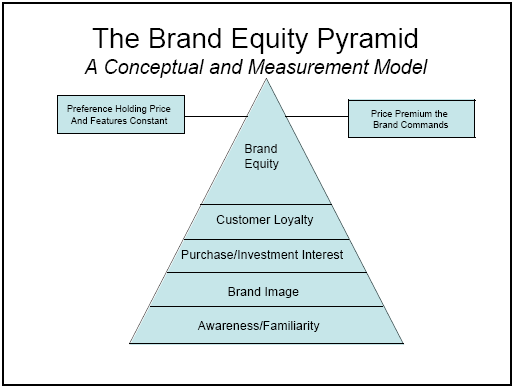
Measurement technique of Brand Equity: Many people believed that brand image is a substitute for the brand image but other scholar argued that brand equity is very different from brand image in a sense the brand should measure separately from brand image. They also suggested two methods to measure a particular brand of a market. These methods are as follows:
- Why customers like a particular brand over the other brands in the market, which offer the same price and characteristics of the same product?
- How a particular brand charges premium price for a product, which is similar to other products offer in the market by other brand?
Conjoint measurement is a popular quantifiable technique to measure brand equity of a particular brand in the market. It shows how customer made a balance between the price of a particular brand product and the characteristics of that product of the same brand. When in the traditional scaling method weight calculated by the total weight of the total factors, here only one weight is measured.
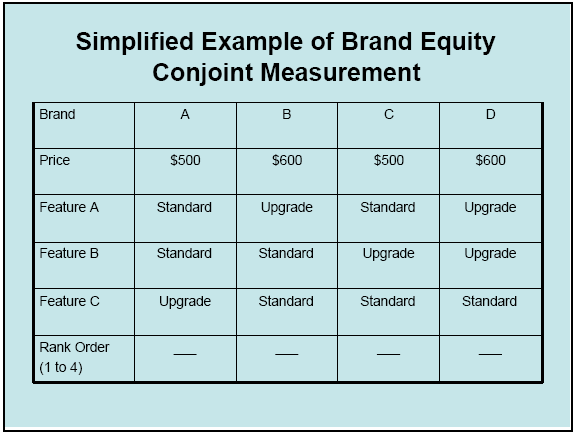
Brand Positioning: Fennell & Allen (2004) argued brand positioning is a technique to position the brand in the mind of the customer about the other competitive brands in the market. It is the functions of a brand in term of quality, price, innovation, image, leadership in the market, safety, reliability and other issues related to the brand, which perform by the company to position a brand in the mind of the customers. Brand positioning is actually how the customer takes the brand in their mind or perception. The brand manager of company address three functions to position a brand in the market, which includes the brand essence, brand promise and brand personality.
Brand Essence: Anon argues that Brand essence is the core of a brand that narrates the unique features or quality of a particular brand and it should not exceed more than three to four words. In some organization, slogan and essence use in the same term but practical sense brand essence is different from the slogan. Slogan says what the brand is or what the brand want to be, but the brand essence says what features or quality the customer enjoy when using the brand.
- Brand Promise: Brand promise is the exceptional or differential benefit that provided to the customers. The benefit of a brand promise may argue about the product’s function, the pleasant experience to use the product or may be emotional involvement of the customer to the brand.
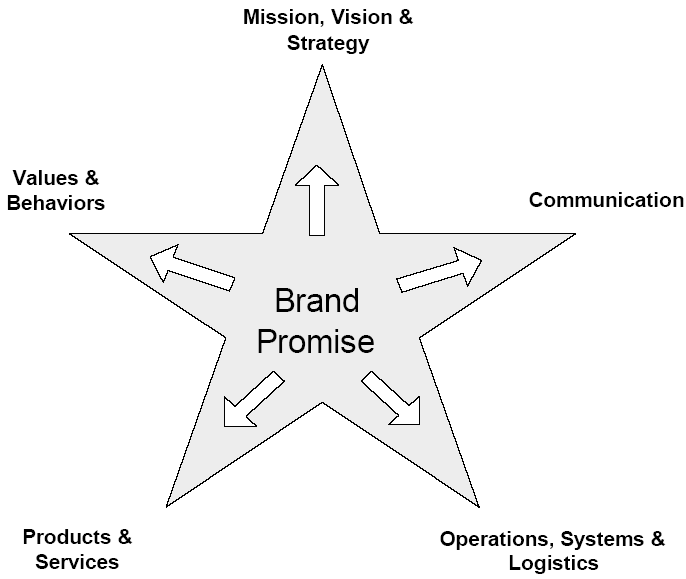
- Brand Personality: Brand personality refers to the perception of the customer about the brand such as hot, cool, spicy etc. To discover the personality of a particular brand the qualitative research is practical because it differs from person to person. As an example, when ask to some persons about the burger of McDonald, some may says it is testy, some may say hot, some may say delicious all of which are the expression of brand personality.
Point of parity and difference:
- Parity: Phillips (2007) argued that Point of parity is an analysis where a company identity the similarities of their brand with the other existing brands in the market which carry the credibility and specific importance to the customers. It is a point where one brand of a company has some features, which are identical to other brands.
- Difference: Point of difference is the different features of the different brands all of which have special meaning to the customers. It identifies and differentiates character of the different brands, which has specific values and requires to building credibility in the brand.
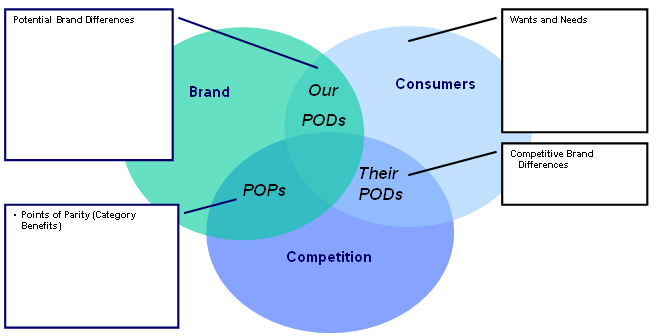
Brand Exploratory: Brand exploratory is a part of brand audit, which includes measuring the brand from the perspective of the customers. It identify how customers aware about a particular brand, how brand position generates long-term mindset of the customers etc. Exploratory audit identify what was the customers perception about the brand before use it and how it changes after the use of the brand. It also explores the customers mind setup about the other brands in the market. This audit executes through the direct data collection from the customers or review the existing research or audit done by others.
Brand Audit of Boost: It is very significant for Boost Juice to initiate a brand audit that would be reviewing for its brand to scrutinise and track how the brand has corresponded to its communication, how the resources of brand equity has responded over time, how strongly its brand is functioning in the global juice market and what is the contribution of the brand.
The comprehensive value of Boost’s brand has placed in the minds of its customers being the market leader that truly know as a successful and precious brand by knowing precisely how its customers recognised the brand. The significantly valuable brands in the global soft juice market that has achieved the position not only just by putting into practice of strong branding strategy but also scrutinising the shifts of customers perceptions with in a period with deliberately flexible to allow these changes. Boost Juice Bar has to remember that the brand is identical to its business and its business at all times would be compliant to the changes of customer perceptions and requests. As a multinational brand ‘Boost’ often, emphasis to the necessity of monitoring the growing customer base with enormous intensity and continuously focus on obtaining new customers, at the same time nourishing the current ones.
Brand Inventory of the Boost Juice Bar: Brand audit of the Boost Juice Bar has assembled through two major parts- brand inventory and the brand exploratory. In this section of this report has been broadly described dynamics of the brand inventories. Some of them are- current profile of the Boost Juice bar, major marketing programs, supply chain management, product description, communicating tools and finally, about their major competitors. The brand identity of Boost Juice Bar submits the criteria how a band take to mean its trademark as an attempts to development the identity to global markets and customers of different countries. On the other hand, the brand image of Boost demonstrates how the customers pick out the brand when its brand identity and brand image would not exactly be the same sense but inter-dependant to each other that its customers preserve (Boost Juice 2007).
- About the Boost Juice Bar: In 2000, Janine Allis as established Boost Juice Bar that has become the central attention of the Australian media as well as consumers as a brand provide with new understanding and scopes in different business levels. As a woman entrepreneur Janine Allis has been achieved great success and focus both home and abroad and demonstrated her capabilities in the points of interest have integrated the fact of Boost provides a healthy alternative of fast food while it has also demonstrated the unprecedented growth and success of the Boost brand. The growth of Boost Juice has evidenced to expand from one to over about 200 stores within few years of its journey. While it has generated major inspiration for Australian business community to generate brand equity by achieving a lot of awards and accolades such as AMEX Franchisor of the Year, and the Telstra Australian Businesswoman of the Year during 2004 by its CEO. This paper has analysed the overall product and brand management of the Boost juice bar to assess the brand audit of the company (RBI 2010).
Marketing and Branding outline: After one year of establishment, the Boost Juice bar driven for franchising from 2001 and it has turned over 170 franchising stores along with its system, production line and its dedicated team and it has an extraordinarily strong and sustainable foundation upon which the brand name of Boost became familiar in the global market. The Boost Juice has elected as one of the top three of highly well liked franchisors in Australia during 2005 while it has also gained the prominent award of American Express Franchisor based on a win-win approach between the Franchisee and the Franchisor. The international expansion strategy of Boost has taken up the attitude to go aboard through Master Franchisees and has already chosen its Master Franchisees in Asian market such as Indonesia, Singapore, in Middle East for instance Kuwait, Dubai, European market in UK and South Africa etc. and continuing its efforts to finding right Partners for rest of the world.
The brand aimed to achieve high growth and high profit in the new markets whilst Boost would continue to growing up its domestic market and pursuing its vision to turn into establishing the brand as most well known and appreciated brand in the global market. The quantity of respond from the international market has evidenced it is enough practical to make its dream into true and Boost is enough confident that it would find the ideal franchising partners. At the same time boost is enough aware about its critical success factors and to maintaining excellent working environment through long-term arrangement that is required to have trusted and respected for both the parties.
Marketing Strategy
- Boost is interested tie up with entrepreneurs to licensing the whole brand any single products.
- To select the interested entrepreneurs, Boost prefer the companies with a strapping reputation for good quality in the market and committed to healthy products, if at all possible with a well-built distribution network at their market.
- Emphasis on both Master franchise and Aussie Franchising,
- Boost is eager to strives both the local and global market,
- Boost use has added media personalities and celebrities for its promotion.
The Boost Retail Range has included the product line as:
Products
- Smoothie on a Stick: The great Smoothies of Boost is upon a stick with packaging of eight pieces are presented along with the same great savour and flavour that the customers can pick and choose from any Boost Juice Bar at his locality
- Energy Lift apple, orange, mango & pineapple
- Green Recovery apple, pineapple, orange, & kiwi fruit
- Wild berry Skinny apple, orange, blueberry, & banana
- Tropical Storm,
- Strawberry Squeeze,
- Mango Magic
- All Berry Bang.
Product Attributes
- All products are 97% fat free
- Each category must contain 40% real fruit
- There would be no artificial colours
- Without any artificial flavours
- All products as testy and yummy
- Most of the products are with berry and apricot flavours and all they are just right for school lunch box of children and even ideal for top desk draw at workplace.
- All Smoothies of Boost are on a stick of 97% fat free materials and 100% yummy to consume with silky and creamy ice-covered yoghurt on the inside as well as a 40% real fruit outer shell
- All the products are made of real fruit with all natural colours and flavours source of fibre with added calcium
- All the drinks are available in individual 50g packs and 35g multi-packs 350 ml and 1 Litre sizes as well as family packs (Boost Juice Bars Australia, 2007),
Logo
The multi colour logo of Boost is comparable with the vision of company to serve the globe with health and nutritious natural drinks
Catalogue
Boost regularly publishes it catalogues with description of ingredients and explaining the food values.
Slogan
Boost Juice has addressed its slogan as- “It’s Amazing Something So Healthy Can Taste So Good” (Boost Juice Bars Australia, 2007).
Competitors
The brand ‘Pure & Natural’ and ‘New Zealand Natural’ are the major competitor in the fruit juice bar franchising sector. Both of the competitors have mainly based on Australia. Both the brands had established before the Boost. Since the both competitors are with similar product and going ahead through franchising but the global expansion of Boost is far better than the other two. New Zealand Natural has almost similar types of fruit juices but it variety is much more than the Boost while it emphasis on ice cream with brand slogan as – ‘Pure Taste Adventure’. ‘Pure & Natural’ is in the market with its twenty five years experience for’ fast, fresh, & healthy food’ catering services and adequate diet including pure + natural is a unique franchise business Purenat (2009) & New Zealand Natural (2010).
During March 2000, the Boost has registered as a private limited company in Australia and titled as “the Boost Juice Bar”. Within last nine years journey it has already discovered almost all areas of Australia and started around 250 outlets as well as major geographical locations of the world. Vision of the Boost has focused on time saving nutritious fast foods whilst traditional fast foods are act behind many complex diseases like high blood pressure, diabetes, kidney infection, stomach infection, skin diseases etc.
Product strengths and weaknesses
Newswire Today (2008) also added that the UK is the 5th global market where the brand Boost has entry in 2007 while the prior entries are Chile, Kuwait, Singapore, and Indonesian market. As Boost is selling a variety of fresh fruit juices, those do not contain any preservatives, chemical flavours, artificial colours, and all the juices are at least 98% fat free and smoothies, the brand become hot favourite. The test of freshly compressed and blended fruit juices are the differentiated charisma of the brand “Boost” whose founder has developed the impression of offering quick, affordable, healthy and natural products collected from organic firm.
Relevant marketing activity
Boost Juice Bar (2009) addressed that from its commencement it has gone ahead in the right way with an exceptional marketing strategy that covers the ideology of ‘above-the-line’ as well as ‘below-the-line’ of campaigns when within five years of establishment it has achieved a 94% brand awareness rate while it has supposed to be as cool as i-pod.
- Branding: As a brand, Boost has been successful to building a widespread and well-accepted brand profile all over the last decay while the branding methods have utilised the public relations, media exposure, radio and television advertisement, online campaigns and other interactive Medias.
- Major campaigns: Boost Juice Bar (2009) mention that it has been executing at least five major campaigns and eight minor campaigns through out the year in stores and the campaigns have demonstrated proven successful to attracting customers at their stores that increases store sales, and gaining tremendous respond from customers.
- Healthy suckers: Boost Juice Bar (2009) has stated that its promotional activities have been performing since 2005 and it has honoured by many awards amounted in more than $1 million in different contest. Un the other phase specially manufactured straws have marketed that has altered previous colours as well as has showed the customers the ways of winning prizes like a brand new car, cost free holidays spending in abroad and so on.
- Customer relations: Customer relation is a differentiation tool of the Boost’s branding strategy that has been positioning it apart from competitors and request the consumers asks customers to email Boost if they could not pleased with the available product and services as well as experience through the “Boost Guarantee” email program. Under this course of action, the Boost has formed its marketing activities entrance into the global market incredibly that also has been ensuring an opportunity towards its consumers for the one-to-one communication while sharing both constructive and depressing experience as well as opinion. By utilizing mass communication modes for example, audio and visual electronic media promotional hierarchy of the Boost has been yearly conducted game contest as well as daily live programs in morning shows. On the other hand, every day of three weeks of a month the Boost has taken some flourishing initiatives to grasp new consumers by offering the Free Boost that has motivated consumers and press them into stores to collect these exciting offers.
- The VIBE club: Including more than 300,000 growing members the Boost’s VIBE club has introduced its Loyalty program in domestic market as well as in global and the membership placement has required completion of a stamp card while consumers have bought either smoothie or juice including a stamp card. Besides membership program, the VIBE club has also provided numerous special facilities like lifetime discount facilities, monthly special packages, and thanks giving email newsletter, free birthday gift hamper and so on. The significant point to be noted that the VIBE club is the most secured and profitable communication tool of the Boost that has been successfully preserving all categories of customer database which has been developing daily (Boost Juice Bar Australia 2009).
Key successes in European market
Newswire Today (2008) reported that Boost Juice Bar has gained tremendous success in UK with in a year of starting it has expended at least eight outlets with most significant respond from the British customers such as at Trafford Centre of Manchester and the Clarendon Centre in Oxford. Richard O’ Sullivan the franchisee of Boost Juice Bars in UK has accomplished an unexpected success by building the business progressively where the Australian retail channel has the benefit of enormous success in the UK market, British customers are taking the brand by storm, and it is offering Boosts juices free all day of opening ceremony of net outlets.
Environment Protection & Social Awareness
UNICEF (2008) admired the brand Boost for its imitative to collaborating with UNICEF to raising funds for distressed children in Pacific Island deal out for vitamin A supplements and suffer from poor diets and added that the product of Boost Juice Bar can reduce the disease caused for malnutrition. UNICEF (2008) also added that brand has also contributed about US$ 620,000 to UNICEF for the children of Asia Pacific region for preventable diseases and sponsored many programs of vitamin A supplementation.
Current branding performance evaluation
Kirby & Blanch (2005) pointed out that Janine Allis the Telstra Businesswoman-2004 was just a household name just ten years back as a single mother looking for job without any speciality backed in Australia after six years stay in Europe. She had appointed as a manager of Nightclub and worked, as a Model where she endeavoured with celebrity, management as well as publishing that provided modest accomplishment before staring own business. Allis is a woman who always looks for to finding the right track of life that could endow with more stability and brilliance on returning at home. Her continuous efforts resulted to making a delicious juice drinks at her kitchen table shown the way to establishing a branded juice and franchise business that ultimately turned her as an owner of a multinational company that meaning above $100m and Allis has rewarded as the triumphant brain that backed the Australia’s most victorious juice chain in global market.
Recommendation
After considering the audit of Boost juice bar, it is essential to provide some recommendation, such as:
- The brand audit of the company must be more comprehensive,
- The company should give proper attention to the brand identity that carry on clear and straightforward massage,
- The brand positioning should be appropriate to address the target customers,
- The brand equity should carry more precise to exert maximum value from the customer and achieve premium-pricing advantages,
- The personality, essence, and promise of the brand should strong enough to position in customers mind,
- The point of parity and difference should be more apparent to establish more credibility of the brand.
Conclusion
The brand audit of Boost Juice Bar will assist the company to mark those factors, which are the foundation of substantial mismatches to connecting brand identity and image with a widespread finding of this brand audit and the rich customers will bear in their mind and acknowledge the brand name and logo of Boost. Thus, Boost Juice Bar would emphasis more to its brand name and logo fort its overall success of the brand and the findings of this accurate audit will assist the company to respond appropriately to resolve any dilemmas raised by the brand managers of Boost Juice Bar.
Reference
Boost Juice. (2007) A bit about Boost, Web.
Boost Juice Bars Australia (2007) About Boost, Franchising, Products & Health. Web.
Chattopadhyay, A. & Jean-Louis, L. (2005) Managing Brand Experience: The Market Contact Audit. Journal of Advertising Research, 1(45), pp. 9-16. Web.
Fateh, S. (2009) Understanding the Language of Branding. Web.
Fennell, G. & Allen, G. M. (2004) Marketing Research: Brand Positioning. Web.
Gopal, R. & Rajagopal, A. (2007) Architecting Brands: Managerial Process and Control. Journal of Transnational Management, 3(12), pp.25-37. Web.
Kirby, J. & Blanch, J. (2005) Janine Allis: Business Secrets behind the Woman behind Boost Juice. Web.
Kuzmina, Y. (2009) Brand Portfolio Management, and the Role of Brand Acquisitions. Web.
Newswire Today (2008) Boost Juice Bars Celebrate their First Anniversary in the UK. Web.
New Zealand Natural (2010) The Company, Product & Promotion. Web.
Phillips, C. (2007) Points of Parity and Difference, BrandAmplitude.Web.
Purenat (2009) A Successful & Health Franchise. Web.
Quarles, C. R. (2008) A Conceptual and Measurement Model for Brand Equity Research. Web.
Raggio R. D. & Leone, R. P. (2007) The Theoretical Separation of Brand Equity and Brand Value: Managerial Implications for Strategic Planning. Journal of Brand Management, Vol-14, pp.380-395. Web.
RBI (2010) Got a Question for Boost Juice. Web.
Romaniuk, J. Sharp, B. Paech, S. & Driesener, C. (2004) Brand and Advertising Awareness: A Replication and Extension of a Known Empirical Generalisation. Australasian Marketing Journal 12 (3).Web.
Saulnier, J. (2008) The brand book, Avera. Web.
Sutherland, M. (2004) ‘Bonding’ Slogan to Brand. Web.
UNICEF (2008) Annual Report, Australia. Web.
Wallström, A. Karlsson, T. & Salehi-Sangari, E. (2008) Building a Corporate Brand: The Internal Brand Building Process in Swedish Service Firms. Journal of Brand Management. Web.
Worthington, S. Russell-Bennett, R. & Härtel, C. 2009. A Tri-Dimensional Approach For Auditing Brand Loyalty. Journal of Brand Management. Web.
